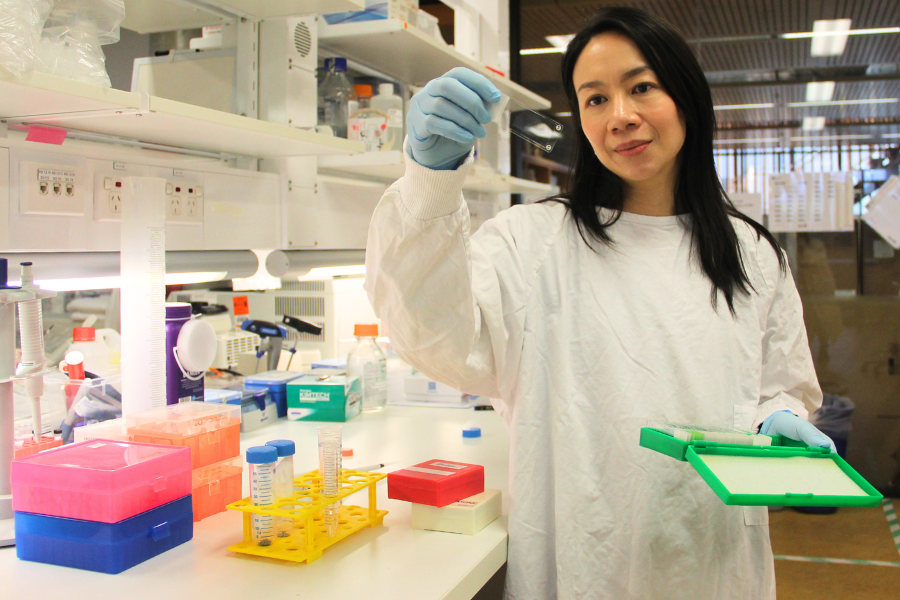Discovering biomarkers of motor neurone disease for earlier diagnosis
A motor neurone disease grant awarded by the Office for Health and Medical Research aims to reduce time to diagnosis to enable earlier intervention, better health outcomes and improved quality of life for people with the condition.
Motor neurone disease is a neurological disease, which affected theoretical physicist and author Stephen Hawking. It is caused by changes to the motor neurone nerve cells, which carry messages from the brain to the muscles, via the spinal cord.

To understand more about the causes of the disease and support earlier detection, the Office for Health and Medical Research, (the Office), has awarded a Motor Neurone Disease Grant to Associate Professor Rachel Tan, a leading researcher in the field and a FightMND Mid-Career Research Fellow at the School of Medical Sciences in the University of Sydney’s Brain and Mind Centre.
This research is part of $2 million in funding awarded through the Office in 2024 to three outstanding motor neurone disease researchers. The Office spoke to Tan to learn more about the disease and what she hopes to achieve using the grant:
What is motor neurone disease?
“Motor neurone disease is a rapidly progressive and debilitating neurodegenerative disease that affects an estimated 1,500 people. The first signs of the condition are often weakness in the hands, feet or voice and it can take 12-18 months to receive a diagnosis. This significantly delays patient access to multidisciplinary care and exacerbates the emotional, physical and financial burden on patients and their families. Earlier diagnosis and intervention would benefit patient outcomes and quality of life, so clinical tools that can help do this are critically needed.”
Motor neurone cells carry messages from the brain to the muscles. Those messages travel along the spinal cord and trigger movement pivotal to important body functions such as swallowing, walking, talking and breathing. In motor neurone disease, the nerves become damaged and no longer function normally.
What do we know about the causes of motor neurone disease?
“Though 10% of affected individuals have a family history of disease, the other 90% do not. Regardless, in all cases of motor neurone disease we do not fully understand what triggers and causes the disease onset.
What we do know is that in healthy brain cells, an important protein called TDP-43 resides in the nucleus, which is the control centre of a cell. TDP-43 plays a critical role in mediating normal cellular function. In patients with motor neurone disease, this healthy protein is lost from the nucleus and accumulates into clumps in motor neurones TDP-43 was discovered approximately 20 years ago and we are still working to understand why this important protein starts to change and behave differently in the brain, and its role in motor neurone disease.”
Can you outline the main aims of your research?
“My research investigates motor neurone disease pathogenesis, which is the study of the triggers and mechanisms involved in the onset and progression of the condition. Using that information, this grant will determine if these changes in the brain can be reliably detected in the body and blood so that we can develop a blood test that will help lead to faster diagnosis and earlier treatment to improve patient outcomes and quality of life.”
What samples and methods will you use in this work?
“In my work, I will study blood and brain samples that have been generously donated by motor neurone disease and stored in NSW biobanks and collection facilities called biorepositories.”
How will the grant from the Office support your research?
“The Motor Neurone Disease Grant from the Office will enable us to employ novel and highly sensitive tools to discover whether other proteins aside from TDP-43, are altered in the patient samples. My team will use high-throughput screening, which is a method for discovery that allows a biological sample to be tested for many different things at once. Building on this information, we will perform more targeted assessments. This is to allow for more sensitive measures of the short-listed proteins, so that we can determine if they indicate motor neurone disease and can be developed into a useful blood test.
The Grant will also fund the laboratory supplies needed to prepare samples for these specialized analyses and support my research, so that my team and I can perform these experiments and advance this work.”
What future impacts do you hope your research has?
“I hope my research will improve understanding of the underlying causes of motor neurone disease and help the development of accessible and reliable measures of these changes that can be used to improve diagnosis, monitor disease progression and determine appropriate treatments for patients, particularly the 90% of individuals affected by the sporadic form of motor neurone disease.”
Updated 5 days ago